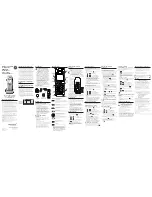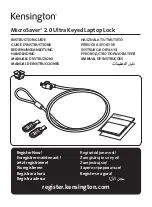
3. Turn the power switch off and on a few times to verify the 3 second power-up muting
delay.
. CHANNEL OUTPUT
1. Look for amplified signal on the scope for channel 1. Switch the input signal and scope
to channel 2 and repeat output test. Check for noisy / contaminated gain pots by
observing general instability on the distortion waveform while adjusting the gain control
levels.
2. Select an 8 ohm load and confirm that this amplifier is producing 300 watts at 1 kHz just
below the point of clipping. Check both channels.
. BRIDGE MODE
1. Turn the power switch off.
2. Set Mode Switch #7 in the on position. The gain control, limiter, and filter switch positions
on CH2 are disabled with Mode Switch #7 on.
3. Set load to both red output binding posts
positive and CH2 negative).
4. Apply a 1.30 VRMS, 1 kHz sinewave input to channel 1 of the amplifier. Check the power
and verify that the output does not immediately collapse. Check for 1000 watts at 8
ohms.
5. Turn power off and place the amplifier under test back into the Stereo mode with output
loads connected to each channel.
l
B I A S
I. Let the amplifier cool down to room temperature.
2. With an input amplitude of 1.3OVrms increase the input frequency to 20kHz. Reduce the
input signal 20dB (80%) from full output. Adjust the crossover trimpot VR43
and
VR166 (CH2) for about a 4OOmVpk-pk crossover spike protruding from the noise trace
on the oscilloscope. It will be necessary to have the oscilloscope measure unfiltered
distortion from the amplifier in order to see the crossover spike. It is necessary to
disable the 80kHz lowpass filter on the analyzer for this test. Further trim so that
the total distortion for that channel is less than 0.1% THD+N.
3. With the trim settings achieved, and with no signal plugged into the amplifier and with an
8 ohm load, verify that the AC idle current from the AC service is no more than 1 .O
amperes.
4. Let the amplifier cool down and check channel 2.
l
SHORT CIRCUIT CURRENT
1. Select a 2 ohm load and apply a 1.3Vrms sinewave (1 kHz) input signal to both channels
of the amplifier. Ensure that power is on and that the gain controls are fully up.
2. While the amplifier is producing power into the loads, apply a short to the output binding
posts of each channel.
In other words, apply a jumper between the red and black
binding posts of each channel. Once this is done, combined AC line current draw for
both channels should be no greater than 13A ac. This is with a 120 volt AC service to
the amplifier. Current may be lower if AC line voltage is lower.
3. Remove the short from each channel and verify that the channels recover in to 2 ohm
loads. The output should not experience any hang up and a full sinewave should be
present just as it was before a short was applied for this test.
4. If the amplifier does not pass any of the above steps, troubleshoot the current limit
section of the amplifier. If steps 2, 3, and 4 above pass, continue to the next test
FREQUENCY RESPONSE.
6
Summary of Contents for PLX Series
Page 2: ... PLX 1202 PLX 1602 PLX 2402 PLX 3002 ...
Page 58: ...H z _ _ _ _ Fi G g u ...
Page 59: ...Q 55 ...
Page 60: ...PLX MAIN MOOULE ASSEMBLY smm 6 20 Y 5 r I_ 1 w ...
Page 81: ... ...
Page 82: ......










































